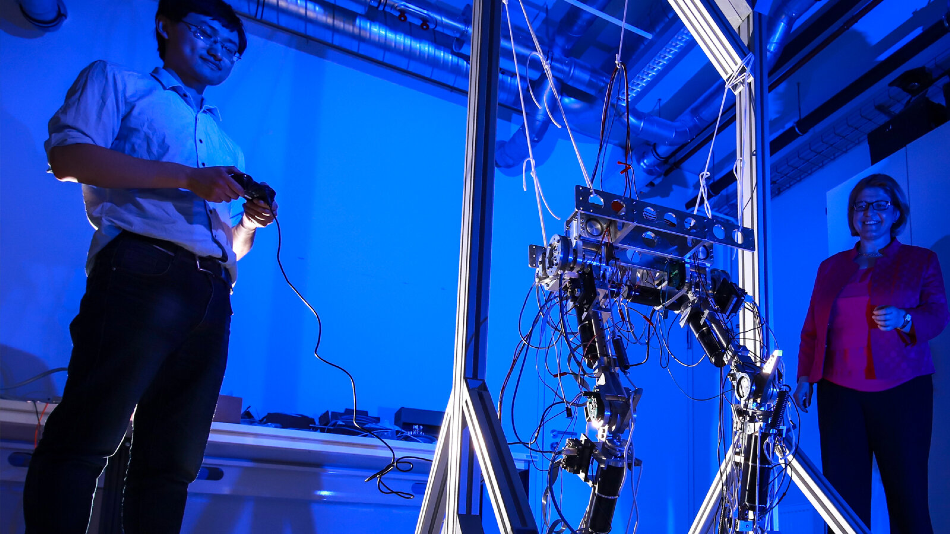Aug 31 2020
An innovative robotic joint was granted a new patent by the German Patent Office on July 23rd, 2020.
 Doctoral student Hongxi Zhu and Professor Ulrike Thomas jointly try out the walking robot, in which the compliant robot joint can be integrated. Image Credit: Jacob Müller.
Doctoral student Hongxi Zhu and Professor Ulrike Thomas jointly try out the walking robot, in which the compliant robot joint can be integrated. Image Credit: Jacob Müller.
The novel robotic joint was invented by Hongxi Zhu, a doctoral student from the Chemnitz University of Technology, and by Ulrike Thomas, Professor and Head of the Professorship of Robotics and Human Machine Interaction and Deputy Spokesperson from the Collaborative Research Center Hybrid Societies.
The latest invention is well-suited to ensure safe communication between robots and humans.
The robotic joint is a so-called compliant joint. Germany holds two patents for adjustable stiffness joints. A previous patent was registered by the German Aerospace Center, while the latest joint was registered by the Chemnitz University of Technology. This patent will be licensed shortly.
New Joint Reduces the Risk of Injury
Since 2016, the developers have been working on this latest robotic joint. The earlier robotic joints were fitted with sensors, predominantly force sensors, to quantify the contact forces that may occur during a collision and to prevent them, if required.
External optical sensors are used by other methods to track the distance between humans and robots. A spring allows the latest robotic joint to absorb energy. This makes it possible to absorb the collision energy, thus allowing the robot to move more quickly in the proximity of a human but without causing any risk to the individual.
There are some more joints that also absorb collision energy by applying springs. The difficulty is to alter the spring hardness in a non-linear manner so that the stiffness and damping of the joint can be adjusted by the robots independently. This would also allow the robots to adapt to tasks, where high forces, for instance, are required to drive a nail into a wall.
With the joint, we have succeeded in covering a very large area and at the same time offering a compact design for the robot joint.
Ulrike Thomas, Professor and Head of Professorship of Robotics and Human Machine Interaction, Chemnitz University of Technology
The compliant joints offer another benefit: scientists can use the stored energy to speed up the movement, allowing a humanoid robot to jump or throw balls.
Professor Thomas had the initial concept of applying an elliptical shape when observing a harmonic drive gear—a shaft gear that has a high transmission ratio—so that a non-linear behavior can be achieved. Hongxi Zhu, a research assistant of Professor Thomas, then rapidly developed the initial concept of the working prototypes.
Background: Professorship of Robotics and Human Machine Interaction
Over the last five years, the Chemnitz University of Technology has established a new robotic team under the guidance of Professor Ulrike Thomas. This team performs intensive studies in the domain of humanoid robotics, particularly cognition and perception, walking robotics, and interaction between humans and robots.
The professorship creates novel mechatronic systems, uses contemporary techniques from artificial intelligence (AI) research, and thus enhances the potentials of robots, beyond the human-robot communication.
The recently developed robots should have the ability to run more steadily or grasp more sensitively, and they should also be able to communicate more safely with their setting. The ultimate aim is to achieve well-suited robotic assistants, be it in production, in care facilities, or for use at homes.
These robots may also offer a valuable service in pandemic situations. Thanks to its research work, the professorship was also able to reinforce the study around the Collaborative Research Center Hybrid Societies quite significantly, so that the initiative was ultimately effective and the SFB 1410 could be established at the Chemnitz University of Technology.
The study was financially supported by funds from the European Social Fund (ESF) and with tax money from the Free State of Saxony based on the budget sanctioned by members of the Saxon State Parliament.